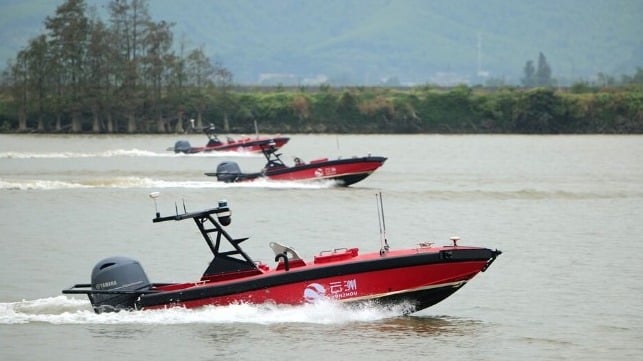Chinese Firm Launches High Speed, Submersible, Autonomous Research Boat

A Chinese autonomous tech company has launched what may be the world's fastest research vessel - the Blue Whale, a high speed unmanned craft with a unique set of features. Designed for typhoon research, this civilian vessel can loiter underwater for 30 days, launch "research rockets," and hit top speeds of about 36 knots - the speed needed to keep pace with most U.S. Navy warships.
The prototype Blue Whale was launched Monday at a pier in Zhuhai. It was funded by the National Natural Science Foundation of China in 2022 and built by a team from tech firm Yunzhou, a leading maker of unmanned vessels for Chinese security forces. Many of the company's other models are marketed for police and military applications and are capable of swarming behavior, interception and high-speed ramming.
— Hi,GBA (@thisisGBA) May 21, 2024
The new research vessel is about 36 feet long, and weighs in at about 12 tonnes. Not only is it faster than perhaps any other research platform, but it is submersible, too: it can loiter up to 200 feet below the surface to escape a passing typhoon, and can stay down for 30 days - much longer than needed to wait out a storm. It can transit at up to four knots underwater, maintaining silence with magnetic fluid drives and special hydroacoustic coatings, according to SCMP.
The "Blue Whale," a cutting-edge high-speed submersible unmanned surface vessel, was launched on Monday in Zhuhai, S China's Guangdong Province, marking a significant breakthrough in China's marine technology. pic.twitter.com/JTlY02iyZz
— People's Daily, China (@PDChina) April 28, 2025
"Through autonomous route planning and mission scheduling, it can position itself near typhoon paths to deploy rocket-powered meteorological sensors to gather critical oceanic and atmospheric data," Yunzhou head engineer Wu Guosong told the outlet.
It carries a multibeam sonar for bottom mapping, and Yunzhou says that Blue Whale has a modular payload architecture, so it could be readily adapted for new purposes.
"It not only provides us with an unprecedented tool for exploring the frontiers of science, but also provides a smart and efficient tool for serving national strategies," said Prof. Chen Dake, an American-educated scientist who heads the project for China's Second Institute of Oceanography.
After sea trials, the R&D team hopes to put the Blue Whale into operation next year.
